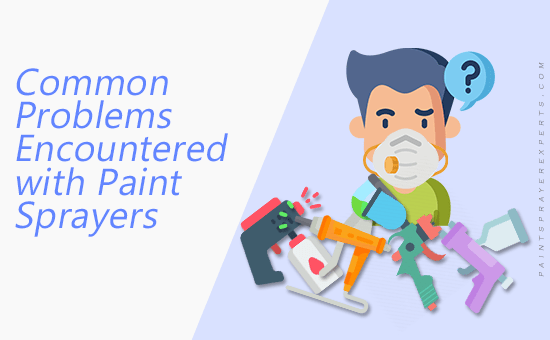
As a professional home painter, I have had the opportunity to work with various types of paint sprayers throughout my career. While paint sprayers can be incredibly efficient and time-saving tools, they are not without their challenges.
In this article, I will share my personal experiences with the most common problems encountered when using different types of paint sprayers and provide practical solutions and advice for DIY users.
So, let’s dive in and explore the world of paint sprayers!
Clogging and Overspray
One of the most common issues faced when using paint sprayers is clogging. Clogs can occur due to several reasons, such as using low-quality paint, inadequate thinning, or improper maintenance.
When a sprayer gets clogged, it affects the spray pattern and can result in an uneven finish or even lead to the sprayer malfunctioning altogether.
Solution: To prevent clogging, ensure that you are using high-quality paint designed for sprayers. Thinning the paint according to the manufacturer’s instructions is crucial. Regularly clean the sprayer components, including the nozzle, filters, and hoses, after each use.
If a clog occurs, disassemble the sprayer and clean the affected parts thoroughly. Utilizing a spray gun cleaning kit with appropriate solvents can help dissolve stubborn paint residues.
Inconsistent Spray Pattern
Another common problem encountered is an inconsistent spray pattern, which can leave visible lines or uneven coverage on the painted surface.
This issue often arises due to incorrect adjustment of the spray pattern settings or an improperly calibrated sprayer.
Solution: Before starting your project, carefully read the sprayer’s instruction manual to understand how to adjust the spray pattern. Test the sprayer on a piece of scrap material to ensure the pattern is uniform and adjusted according to your desired outcome.
If inconsistencies persist, check for any blockages in the nozzle and clean it thoroughly. Additionally, maintaining the recommended distance between the sprayer and the surface is vital for achieving a consistent spray pattern.
Dripping and Paint Runs
Excessive paint buildup or improper technique can lead to dripping or paint runs on the surface being painted. This issue is more likely to occur when using an airless paint sprayer, as the high-pressure system can cause paint to accumulate or pool in certain areas.
Solution: To prevent drips and runs, maintain a consistent speed and distance while spraying. Begin and end each stroke off the surface to avoid over-application.
Apply several thin coats rather than one heavy coat, allowing adequate drying time between each layer. If drips or runs do occur, gently sand the affected areas after the paint has dried and recoat as necessary.
Oversaturation and Lack of Control
Inexperienced users often struggle with oversaturation and lack of control when using paint sprayers. These issues can result in excessive paint on the surface, leading to long drying times, uneven finishes, and wasted paint.
Solution: Practice proper technique and maintain a steady hand to achieve better control. Start with low pressure or speed settings and gradually increase as you become more comfortable.
Keep the sprayer at a consistent distance from the surface and use even, overlapping strokes for uniform coverage. It is better to apply multiple thin coats than a single heavy coat, as this allows for better control and more even results.
Paint Splattering
Paint splattering occurs when the sprayer ejects paint particles unevenly, resulting in small splatters or dots on the surface. This issue can be attributed to several factors, including a worn-out or damaged sprayer tip, improper paint consistency, or excessive pressure.
Solution: Check the condition of the sprayer tip and replace it if necessary. Ensure that the paint is properly mixed and thinned to the manufacturer’s specifications.
Adjust the pressure settings according to the viscosity of the paint. If splattering persists, try increasing the distance between the sprayer and the surface to allow the paint particles to disperse more evenly.
Paint Compatibility and Texture Issues
Sometimes, paint compatibility issues can arise when using certain types of paint sprayers. For example, some sprayers may struggle with thicker paints, such as textured or heavily pigmented coatings.
If the paint is not compatible with the sprayer’s capabilities, it can lead to clogs, uneven spray patterns, or even damage to the sprayer.
Solution: Before using a paint sprayer, always check the paint manufacturer’s recommendations regarding compatibility with sprayers. If you encounter compatibility issues, consider using a paint thinner or conditioner to adjust the paint’s viscosity.
Alternatively, opt for a sprayer specifically designed to handle thicker paints. Remember to thoroughly clean the sprayer after using textured or specialty paints to prevent any residue buildup.
Electrical or Mechanical Malfunctions
Occasionally, paint sprayers may experience electrical or mechanical malfunctions, causing them to stop working or perform poorly. These issues can be frustrating and may require troubleshooting or professional repairs.
Solution: If you encounter electrical issues, such as a sprayer not turning on or intermittent power supply, ensure that the power cord is properly connected, and check for any blown fuses or tripped circuit breakers.
For mechanical problems, refer to the sprayer’s instruction manual for troubleshooting steps. If the issue persists, contact the manufacturer or a professional repair service for assistance. Regular maintenance and inspections can help prevent such malfunctions.
Safety Precautions and Health Concerns
When using paint sprayers, it’s essential to prioritize safety and address potential health concerns.
Sprayers generate fine paint particles that can become airborne, posing risks if inhaled or if they come into contact with eyes or skin. Additionally, overspray can affect nearby surfaces or objects.
Solution: Always wear proper personal protective equipment (PPE), including a respirator mask, safety goggles, gloves, and protective clothing, when using a paint sprayer.
Work in a well-ventilated area or consider using additional ventilation equipment to minimize exposure to fumes. Cover surrounding surfaces and objects with drop cloths or plastic sheets to protect them from overspray. Take breaks and avoid overexertion during extended painting sessions.
Noise and Environmental Considerations
Paint sprayers, particularly airless sprayers, can generate significant noise levels during operation. This can be a concern for homeowners or when working in noise-sensitive areas. Additionally, paint overspray can impact the environment if not properly controlled.
Solution: When working in noise-sensitive areas, consider using quieter HVLP (high-volume, low-pressure) sprayers or opt for sprayers equipped with noise reduction features.
Communicate with homeowners or neighbors about your painting schedule to minimize disruptions. To reduce environmental impact, use proper containment measures, such as spray tents or barriers, to control overspray. Consider using low-VOC (volatile organic compound) paints for environmentally-friendly options.
Final Thoughts

While paint sprayers offer numerous benefits for both professional painters and DIY enthusiasts, they can present challenges if not used correctly. By understanding and addressing the common problems encountered with different types of paint sprayers, you can achieve outstanding results with ease.
Remember to use high-quality paint, follow the manufacturer’s instructions, and practice proper technique to overcome these issues.
By understanding these challenges and implementing the provided solutions, DIY users can tackle their painting projects with confidence and achieve professional-quality results.
With patience, practice, and a little troubleshooting, you can unleash the full potential of paint sprayers and transform your home with beautiful, professional-quality finishes. Happy painting!
